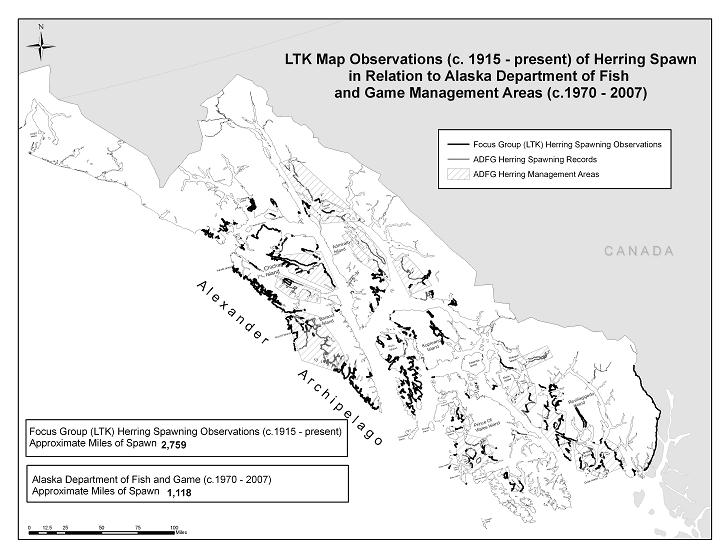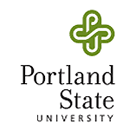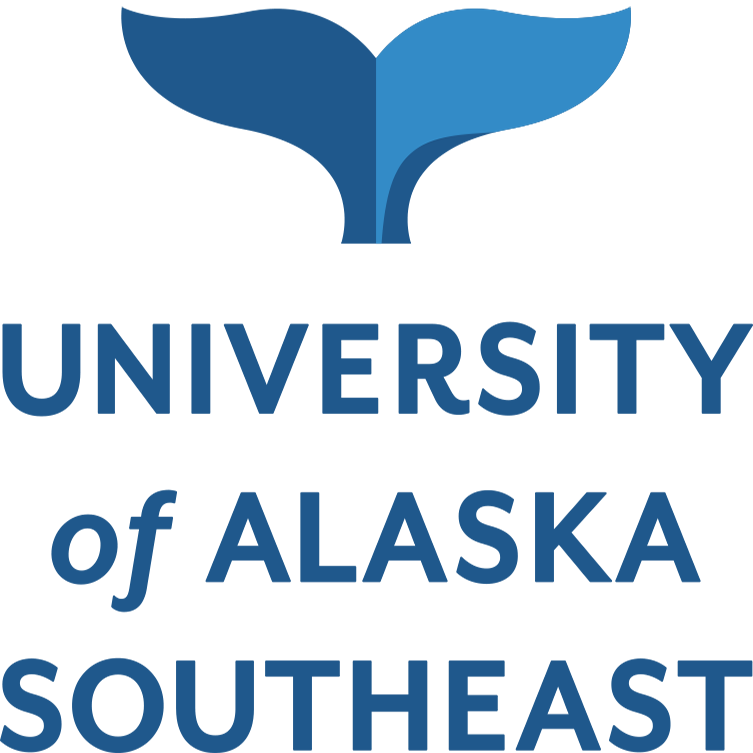Recommendations
Archaeology
• Forest Service archaeologists and contractors as well as other archaeologists working in the region do a better job documenting all manner of excavations by explicitly describing areas excavated, volumes excavated, recovery, identification,and analytical techniques used. This will ensure that important herring sites are not missed.
• all archaeologists working in Southeast Alaska employ 1/8 inch (or finer) mesh screens and/or recover bulk samples to facilitate sampling of herring and other small-bodied fish.
• special efforts be directed to sampling sites for herring in the vicinity of localities where herring were historically abundant, including Sitka, Craig, and Auke Bay (near Juneau).
• further work be conducted at Garnes Point to see if the dominance of herring found by Moss (1989a) is characteristic of other areas of the site. An initial step might be locating materials excavated by the State of Alaska in 1987 and examining these samples for the presence of herring.
• special efforts should also be directed to testing sites within the territories of the Huna, Klukwan, Yakutat, Auk, and Taku kwáans, where very few sites have been investigated.
• additional work is required for sites dating from all time periods, but sites older than 4500 cal BP and more recent than 500 cal BP are particularly poorly represented. Investigators studying sites dating to these time periods should be vigilant about using data recovery techniques that will insure adequate sampling of herring.
LTK, Research and Management Recommendations
• LTK should be documented for the remaining communities not included in this study, including Yakutat, Haines/Klukwan, Hydaburg, Wrangell, and Metlakatla. These communities have unique, if not exceptional features. For example, the Tsimshian community of Metlakatla has a herring fishery that is independently managed by the tribe due to their sovereign status as a reservation; at times they compete with Alaska managed fishers for the same herring schools. Yakutat, significantly, has seen a noticeable resurgence in herring spawning in Yakutat Bay in recent years for the first time since the herring seiners from the reduction plant fleet fished it heavily nearly a half century ago. Wrangell was another major spawning area that has been depressed in recent years. There is also limited herring spawn in the Haines area. And Hydaburg is said to have been the recipient of a major herring transplantation, successfully carried out by local Haidas and Tlingits.
• Critical parts of the herring life cycle, including larval, juvenile, and adult recruitment stages should be the subject of further investigation. LTK is not as well developed in these areas, because herring are often out of human sight and pathways during these phases of development, in contrast to spawning, which is comparatively well-observed. Similarly, scientific studies of local conditions of herring development would reveal the unity and diversity of conditions under which herring thrive or do not thrive. Also in need of further study are the roles of key “development” variables, such as pollution (e.g., in Silver Bay and Auke Bay) and hatcheries (e.g., in Deep Inlet), on herring populations in key historical habitats, particularly in the larval and spawning stages of the life cycle.
• Efforts should be made to develop herring restoration plans based on historical herring spawning areas and transplantation and spawning enhancement techniques documented in this study. Although herring transplantation has been tested in limited scientific studies, apparently with little success (Hay and Marliave 1988; Ware and Tovey 2004), these tests have not been based on LTK and techniques, which the oral historical record suggests were successful. Perhaps restoration plans could be carried out in conjunction with local Alaska Native tribes, whose members are the best repositories of local knowledge about herring habitat and enhancement techniques. This should not be a substitute for conservative management of remaining herring populations, but could enhance
depressed or defunct runs of herring. However, such a program would have to be launched at an appropriate regional—perhaps even international—scale (other techniques for herring enhancements are being piloted in Japan) and with corresponding commitments to long-term monitoring, so effectiveness could be evaluated over time and under different ecological conditions. As a starting point, we recommend that a herring restoration plan be developed and piloted using key historical spawning sites identified and mapped for this study that are considered by consultants to have declined in productivity. Potentially, all the historical spawning sites we have mapped could be included in the plan as herring restoration sites. However, effort should be prioritized based on: 1) the current quality (water and substrate quality, etc.) and productivity trends (stable or increasing presence of spawning herring) of the site's habitat; 2) suitability of the site for monitoring by management agencies and communities; 3) competing uses of the site (such as commercial fishing, recreation, or aquaculture); and 4) hypothesized relationships between the proposed restoration sites and other active and historical herring spawning populations and spawning grounds. Given the dynamics of the region's herring population, a networked approach to restoring key historical spawning sites within one or two sub-regions, such as the greater Sitka Sound/Salisbury Sound area, would likely be more constructive than isolating efforts on a single site, or a few widely dispersed sites. Such restoration efforts would serve to enhance diverse spawning locations and improve herring biodiversity, resilience, and adaptive potential. By concentrating efforts on restoring key historical spawning areas, greater conservation and enhancement of herring stocks can be achieved.
• Increased monitoring of particular herring spawning areas should be carried out to reveal how climate and other environmental changes are affecting local herring populations. Some monitoring is already being conducted formally and informally by tribes and other associations, such as STA, and individual fishers. But this could be augmented and coordinated with other long-term monitoring efforts beyond the aerial and deposition surveys carried out by Fish and Game. Sites of increasing herring productivity (such as around Yakutat and perhaps Hoonah) and decreasing productivity (such as Kah Shakes Cove, Auke Bay, and areas of Sitka Sound). Similarly otolith and DNA studies could be carried out to further explore genetic and biological relationships between different local populations of herring. In addition, impacts, such as noise pollution and contamination from development, could be monitored vis-à-vis key indicators of local herring population health and LTK observations over time as documented in this study. With respect to climate change, it has been hypothesized (Planque, et al. 2010) that the demographic effects of targeted fishing (e.g., removal of mature spawners) may have “substantial consequences on the capacity of populations to buffer climate variability through various pathways (direct demographic effects, effects on migration, parental effects).” Similarly, “selection of population sub-units within meta-populations may also lead to a reduction in the capacity of populations to withstand climate variability and change” How current herring fishing patterns might play out in relation to realized and anticipated climate change patterns would be greatly enhanced if the historical fishing and observational data presented in this report could be more closely correlated with historical patterns of climate variability and herring abundance and spatio-temporal variability within Southast Alaska.
• Further studies correlating the presence or absence of herring in connection with critical environmental variables such as ecozone, eelgrass and kelp habitat, and sea surface temperature should be carried out to augment the data synthesized here, using GIS as a tool. Although we consulted maps of eelgrass beds and kelp forests, most are not detailed or historical enough to correlate with spawning trends. Historical mapping of kelp and eelgrass beds,based on documentary records and LTK, would be beneficial in further assessing environmental changes in these habitats and their potential effects on the productivity local schools of spawning herring. Recent efforts by NOAA, the Nature Conservancy, Fish and Game and other partners to map Southeast Alaskan shorelines and estuaries could yield important new data to correlate with the presence or absence of herring schools in these areas (Laura Baker, pers. comm. 3 August, 2009, see http://akr-mapping.fakr.noaa.gov/sz_demo3/). It is important to monitor trends in the quality of herring habitats at meaningful scales, particularly those areas defined by the LTK presented in this study. Some areas, such as parts of Port Frederick near Hoonah and Silver Bay near Sitka, seem to be improving following the decline of contaminants and sediments introduced by industrial logging and pulp production, while other areas, such as Auke Bay, remain have not recovered despite the cessation of commercial herring fishing for decades. But there are other factors that may effect spawning habitats and substrates, such as rising sea temperatures due to global warming, pollution, invasive species, reduced light (due to sediment) and diseases. All these factors have the potential to cause significant deterioration of kelp and eelgrass patches, (AKNHP 2005)
• Subsistence fishers concerns should be more carefully considered in the research and management processes. Alaska’s management system is ostensibly participatory, but tends to be heavily weighted toward the concerns of contemporary commercial interests rather than the full spectrum of participants. This leads to an overemphasis on maximum yield for certain fisheries, like sac roe, at the potential expense of the subsistence fisheries, such as roe on branches, and “ecosystem services” for other constituents of the marine environment. Our interviews in Sitka demonstrated strong feelings of concern and even distrust of and disenfranchisement from herring fisheries management. Members of the Sitka Tlingit tribe in particular seem to feel that their management concerns were not being listened to and that the fishery was not being managed in the best interest of subsistence users or the marine ecosystem in general. But they were not alone. Other constituencies, such as the Herring Coalition, headquartered in Ketchikan, were made up primarily of non-Native trollers and recreational fishers. This broad, strong citizen interest in the status and science of herring is a great asset to the governance of critical resources to marine ecosystems. But only if managers listen.
• Participatory research methods should be employed to decide, in conjunction with fishers, what further research needs to be carried out. Issues such as the impact of test fisheries, appropriate spatial scales for applying biomass models and harvest quotas, and the timing of sac roe harvests to minimize impacts on spawning are topics all ripe for investigation based on LTK observations and concerns documented in this study.



